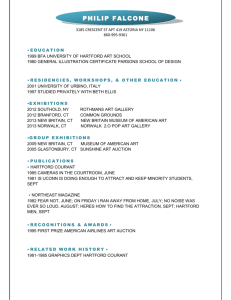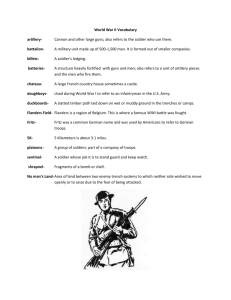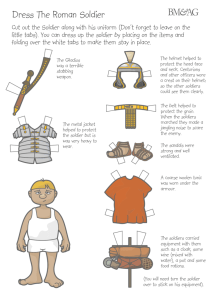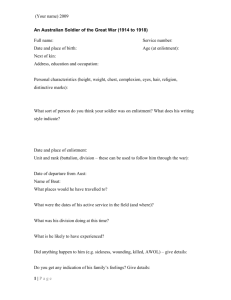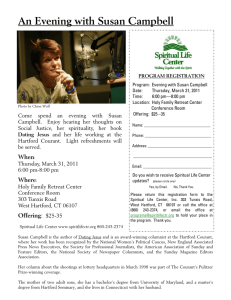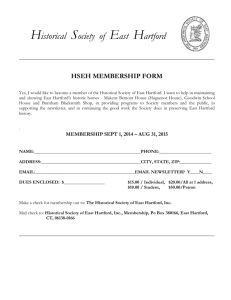to view the Connecticut State Historical Registry form
advertisement
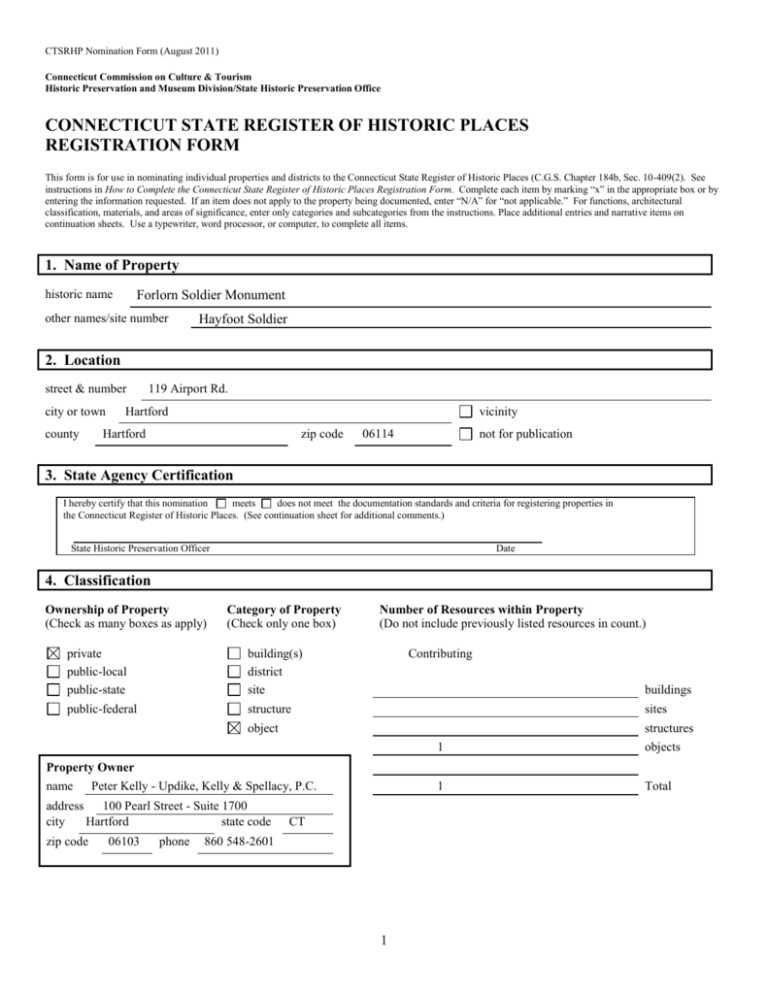
CTSRHP Nomination Form (August 2011) Connecticut Commission on Culture & Tourism Historic Preservation and Museum Division/State Historic Preservation Office CONNECTICUT STATE REGISTER OF HISTORIC PLACES REGISTRATION FORM This form is for use in nominating individual properties and districts to the Connecticut State Register of Historic Places (C.G.S. Chapter 184b, Sec. 10-409(2). See instructions in How to Complete the Connecticut State Register of Historic Places Registration Form. Complete each item by marking “x” in the appropriate box or by entering the information requested. If an item does not apply to the property being documented, enter “N/A” for “not applicable.” For functions, architectural classification, materials, and areas of significance, enter only categories and subcategories from the instructions. Place additional entries and narrative items on continuation sheets. Use a typewriter, word processor, or computer, to complete all items. 1. Name of Property Forlorn Soldier Monument historic name other names/site number Hayfoot Soldier 2. Location street & number city or town county 119 Airport Rd. Hartford vicinity Hartford zip code 06114 not for publication 3. State Agency Certification I hereby certify that this nomination meets does not meet the documentation standards and criteria for registering properties in the Connecticut Register of Historic Places. (See continuation sheet for additional comments.) State Historic Preservation Officer Date 4. Classification Ownership of Property (Check as many boxes as apply) Category of Property (Check only one box) Number of Resources within Property (Do not include previously listed resources in count.) private public-local public-state building(s) district site Contributing public-federal structure sites object structures buildings 1 objects 1 Total Property Owner name Peter Kelly - Updike, Kelly & Spellacy, P.C. address 100 Pearl Street - Suite 1700 city Hartford state code zip code 06103 phone CT 860 548-2601 1 Forlorn Soldier Monument Hartford Name of Property Municipality 5. Historic Preservation Council Approval date Comments 6. Function or Use Historic Functions Current Functions Recreation and Culture N/A (Enter categories from instructions) (Enter categories from instructions) Subcategory: monument/marker 7. Description Architectural/Archaeological Classification Materials (Enter categories from instructions) (Enter categories from instructions) monument/marker foundation brownstone walls roof other Narrative Description (Describe the historic and current condition of the property on one or more continuation sheets.) SEE CONTINUATION SHEET The Forlorn Soldier Monument is a typical Civil War figure rendered in Portland brownstone.It is located on a small, grassy plot of land located approximately 100 yards off of Airport Road and adjacent to I-91 in the Brainard Airport area of Hartford. The parcel was once part of a nearby stoneyard that once belonged to James Batterson. The Forlorn Soldier is approximately eight feet tall and two feet wide and is one of the few remaining brownstone Civil War monuments in the state. The soldier is shown wearing a kepi (a flat circular hat with a visor) with a head of wavy hair and a full beard. He is depicted glancing to the right and wearing an overcoat that is belted at the waist with a cape draped behind his shoulders. A bayonet and other tools of war are fastened to the belt. His right foot is set forward and 2 next to the remains of a rifle butt. The rest of the rifle is missing. The hands are also missing, but one can tell from the position of arms that they once rested on his rifle. The base of the statue consists of a low,brownstone truncated pyramid. A bronze plaque is attached to the front of the base and reads the following in raised block capitals: DUM TACET CLAMAT [Though silent, he speaks] REJECTED AFTER THE CIVIL WAR FOR A FAULTY FOOT POSITION, THIS BROWNSTONE UNION SOLDIER WAS ACQUIRED IN 1895 BY MICHAEL H. AND JOHN KELLY, STONE CUTTERS, PLACED AT THE CORNER OF CHARTER OAK AVENUE AND UNION STREET IN HARTFORD WHERE, BUFFETED BY FLOOD AND BRUSHED BY VANDALS, HE STOOD UNTIL 1968 WHEN J. MICHAEL KELLY, A GRANDSON, MOVED HIM TO A FAIRER SITE, RESTORING HIS BATTERED ENTITY WITH THE LOVING CARE HE HAD BEEN SO LONG DENIED. Due to the vulnerability of the material, it has suffered the effects of time, vandalism, and past flooding. The brownstone has failed (spalled, delaminated and cracked) particularly in the area of the face and hands. The rifle and other components are also missing. Throughout the first half of the last century, various attempts at repair have been made. The Forlorn Soldier Hartford Name of Property Municipality 8. Statement of Significance Applicable Connecticut Register Criteria (Mark “x” in one or more boxes for the criteria qualifying the property for State Register listing.) 1 That are associated with events that have made a significant contribution to our history and lives of persons significant in our past; or 2 That embody the distinctive characteristics of a type, period, or method of construction, or that represent the work of a master, or that possess high artistic values, or that represent a significant and distinguishable entity whose components may lack individual distinction; or Levels of Significance (local, state) Local and state significance Areas of Significance Other 3 That have yielded, or may be likely to yield information important in prehistory or history. Significant Dates 1866-1869 3 (Enter categories from instructions) Significant Person Batterson, James G. Cultural Affiliation (Complete if Criterion 3 is marked) Architect/Builder Batterson, James G. Narrative Statement of Significance (Explain the significance of the property on one or more continuation sheets.) SEE CONTINUATION SHEET The Forlorn Soldier was created sometime between 1866 and 1869 by James G. Batterson’s Hartford based New England Granite Works Company. Today, it stands as one of the oldest Civil War monuments in the State of Connecticut, with deep ties to the war period and one of the state’s principal business leaders. Batterson, the founder of Travelers Insurance Company, was one of the nation’s foremost monument builders, erecting fourteen monuments in the State of Connecticut, as well as monuments around the country, including Gettysburg National Battlefield and the National Cemetery at Antietam National Battlefield. Despite the condition of the monument, the majority of similar Civil War statues found throughout the state and region are constructed of granite, making this a rare example of the type. It is, therefore significant under Criterion 2. Other brownstone Civil War monuments created by Batterson include the Bristol Soldiers’ Monument in West Cemetery and the East Hartford Soldiers’ Monument in Center Cemetery, both among the oldest Civil War monuments in the state. As a sedimentary stone, brownstone is notorious for its tendency to flake and separate over time. This is the very reason that the monument has been for generations referred to as the “Forlorn Soldier.” His rough exterior, with missing face and hands, speaks to the 150 years that have passed since war engulfed the nation. In many ways, both in his outward appearance and his present location, the Forlorn Soldier speaks to a 21st Century generation that has forgotten past deeds and sacrifices. Legend has it that the Forlorn Soldier was actually a reject because the wrong foot was put forward for the soldier’s position at parade rest. This, however, is not an historical fact, as the position of statues varied greatly during this time period. What is more likely is that the shift to the use of granite made the Forlorn Soldier obsolete. The Soldier therefore remained at Batterson’s work yard, at the corner of Charter Oak Avenue. The yard was purchased by Michael and John Kelly in 1895 and later moved in 1938 to what is today the Airport Road area of Hartford. The Forlorn Soldier was left behind, until 1968, when the Kellys, moved him to his present location at 119 Airport Road. The shop and almost all the land were ultimately sold to the Metropolitan District Company, but the Kelly family, today represented by Attorney Peter G. Kelly, maintained ownership of the statue and the land five feet out in each direction from the base. The Kellys paid for some conservation efforts and added the plaque to the base of the statue. 4 The Forlorn Soldier has periodically been the subject of keen interest for Hartfordites. On July 12, 1932 the Hartford Courant ran an article deploring the statue’s condition, and announced “We think it’s high time something was done about it.” Noting the effects of the weather and the vandalism the newspaper stated that “He has received as many wounds as any of his brothers” who fought in the war. The article ultimately insisted that even though the statue had not been carved correctly, with the wrong foot forward, nonetheless “Hartford has a grand opportunity to erect a memorial, not to the unknown soldier, but to the awkward soldier, who fought as well as an unfamiliar military machine, and as efficiently when his time came as the pride of the drill sergeant’s heart. The opportunity is there, though Hartford probably won’t accept it. Nevertheless, next Memorial Day, we’re going to decorate old Hayfoot in memory of the soldiers who, like him, could never remember whether right was right or left.” Just a few years later, on April 10, 1936, following the great flood that ravaged the city and resulted in significant damage to the soldier, his head having been taken off by a floating porch detached from a house, the Hartford Courant published another article, this time entitled “His Epitaph – – He Began On Wrong Foot,” and speaking to the likely death of the monument. “The soldier stood at the edge of the stone yard until the flood toppled him from his pedestal….Whether the wind, whether in flood beaten veteran will be given a soldier’s burial or just broken up and tossed on the rubbish heap remains to be told.” Just two days later, on April 12, the newspaper followed with another disheartening title, “Taps for ‘Hayfoot.’” Retelling history of the statues improper production, the author surmised that “probably he was indignantly rejected by the town whose green he was intended to grace,” and that “Hartford may have snickered when he was first set where he stood until recently, but as time passed and he proved his faithfulness, it grew to cherish him.” “But now,” continued the author “apparently, it is taps for old ‘Hayfoot.’ What was once a gallant and faithful, if an unorthodox, figure is now merely a battered chunk of sandstone. ‘Old soldiers,’ says the cockney ballad, ‘never die, they only fideaw’y.” ‘Hayfoot’ has fided, but the memory of his grave assurance that the holy wrong was eminently correct will long remain.” Not long after this article was published a local resident, William H. Felt, wrote a letter to the Courant stating, “I must say that I had enjoyed his standing guard in that same spot for so many years. Now he is fallen down on the job, though I do think he should have been relieved from duty more often, it brings a great sadness to my heart. To think that just one more of the old landmarks of the Hartford, I used to know, has gone the way of so many others. And something should be done about it.” The Courant finished out its 1936 articles on May 25, with “Almost Forgotten,” stating “Monuments are erected to keep alive the memory of war. But sometimes even the monument is forgotten by the public.” This was the last word from the newspaper until 1968, when it published an article on November 17 entitled “They Saved the Old Soldier.” Focusing on the history of the soldier and on the Kelly Brothers, who had purchased the stone yard from James Batterson, the author explains the Kelly’s conservation efforts. How they fixed the hands, the face, moved the statue to new site, placed it on a new base, and added the brass plaque. The article concluded that “the Kelly’s will always take care of him.” The statue once again, however, fell into disrepair and distant memory, prompting Courant columnist Susan Campbell to write in November 11, 1998 about the mysteries related to the statue. Why was the wrong foot forward? Why was he carved from brownstone? Although she had no clear answers to such questions, Campbell ultimately concluded “It’s a piece of Gettysburg, Antietam, and Bull Run, a small chunk of ground sanctified by sacrifice and pain. There’s blood in that stone, and tears and the cry and smoke of a battle some will never get over.” 5 Forlorn Soldier Monument Hartford Name of Property Municipality 9. Major Bibliographical References Bibliography (Cite the books, articles, and other sources used in preparing this form on one or more continuation sheets.) Ransom, David F. Connecticut’s Monumental Epoch: A Survey of Civil War Memorials, The Connecticut Historical Society Bulletin, Volume 58 (1993): 222 – 224. Warshauer, Matthew and Mary M. Donohue. “Memorials to a Nation Preserved,” Connecticut Explored, Volume 9 (Spring 2011): 38–42. Warshauer, Matthew. Connecticut in the American Civil War: Slavery, Sacrifice, and Survival (Wesleyan University Press, 2011). “The Lighter Side: Old Hayfoot,” Hartford Courant, July 12, 1932 “His Epitaph – – He Began On Wrong Foot,” Hartford Courant, April 10, 1936 “Taps for ‘Hayfoot,’” Hartford Courant, April 12, 1936 “Old Hayfoot - Tokens of the Hartford of Other Years Are Disappearing,” Hartford Courant, April 23, 1936 “Almost Forgotten,” Hartford Courant, May 25, 1936 “They Saved the Old Soldier,” Hartford Courant, November 17, 1968 Susan Campbell, “Questions Are Legacy Of Forlorn Monument,” Hartford Courant, November 11, 1998 10. Geographical Data Acreage of Property N/A Municipal Map, Block and Lot Number and UTM Coordinate (If possible) (Place additional UTM references on a continuation sheet.) 1 2 Map Block Zone Easting Lot 3 Northing 4 Zone Easting See continuation sheet Verbal Boundary Description (Describe the boundaries of the property on a continuation sheet.) Monument stands on a 10 ft square parcel of land. Boundary Justification (Explain why the boundaries were selected on a continuation sheet.) 6 Northing 11. Form Prepared By name/title Matthew Warshauer, Professor of History and Co-Chair of the Connecticut Civil War Commemoration Commission organization street & number city or town Central Connecticut State University date 1615 Stanley St. January 4, 2013 telephone New Britain state CT Email: WarshauerM@ccsu.edu CTSRHP Nomination Form (March 2010) Connecticut Commission on Culture & Tourism Historic Preservation and Museum Division/State Historic Preservation Office CONNECTICUT STATE REGISTER OF HISTORIC PLACES REGISTRATION FORM – Continuation Form Name of Property Municipality 7 860-832-2803 zip code 06053 CONNECTICUT STATE REGISTER OF HISTORIC PLACES REGISTRATION FORM Forlorn Soldier Continuation Sheet 8 Forlorn Soldier Continuation Sheet Forlorn Soldier, Image 1 9 Forlorn Soldier Continuation Sheet Forlorn Soldier, Image 2 10 Forlorn Soldier Continuation Sheet Forlorn Soldier, Image 3 11 What did the Forlorn Soldier look like? Granby Soldiers’ Monument, 1868 12 Batterson Monuments Soldiers Monument – Bristol Soldiers Monument – East Hartford Soldiers Monument – Granby Soldiers Monument – Guilford Forlorn Soldier – Hartford Weld Monument – Hartford Soldiers Monument – Manchester Soldiers Monument – Meriden Knight Hospital – New Haven Soldiers Monument – Norwich Soldiers Monument – Portland Soldiers Monument – Southington Soldiers Monument – Stonington Wolcottville Soldiers Monument – Torrington 13 14
